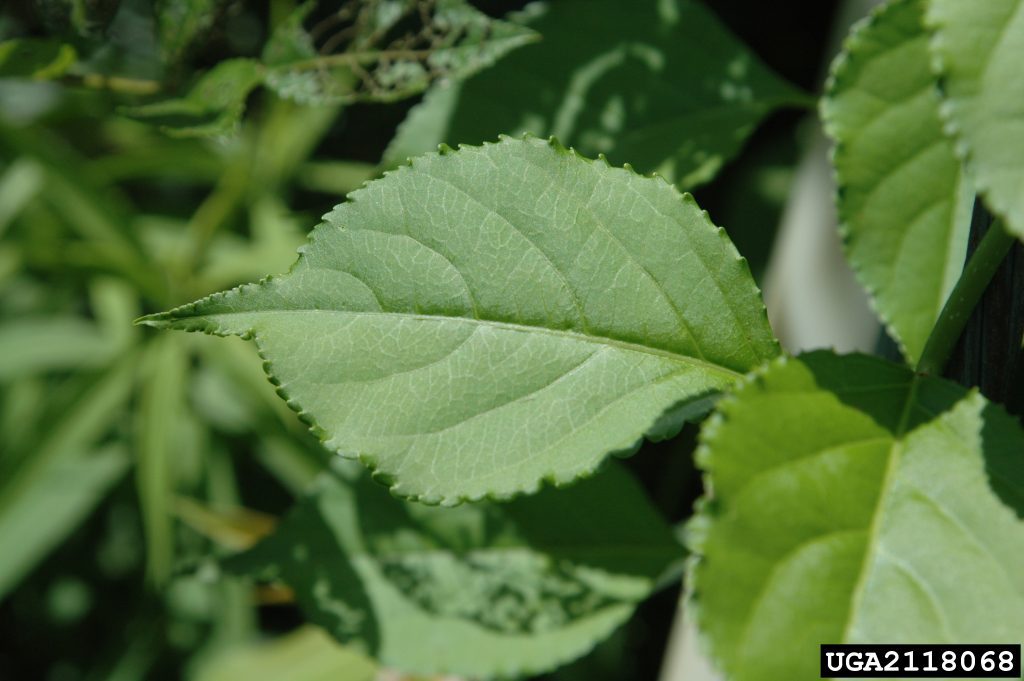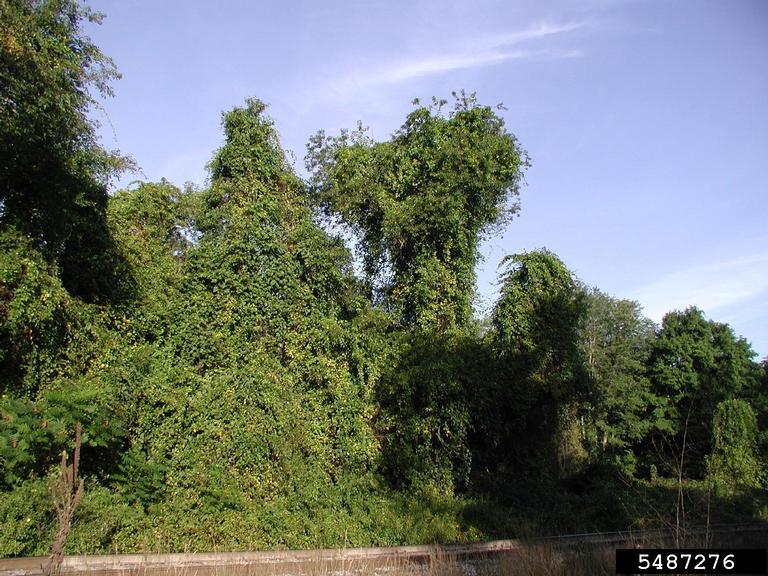Oriental bittersweet
(Celastrus orbiculatus)
Biological Category
Plants
NY Legal Status
Prohibited
Species Type
Vine
DESCRIPTION
Oriental bittersweet is a perennial, woody vine that can ascend to the tops of canopy trees or sprawl horizontally across fields. The vine climbs tree trunks using spiny projections along its stems and its leaf scars also lodge in the tree bark to allow it to climb. The light brown stems grow 2-4 inches in diameter and grow up to 59 ft. in length. Leaves are alternate and rounded and scalloped/toothed along the edges, often with pointed tips. The white to greenish flowers they produce tend to bloom in clusters from May to June. The red berry fruits ripen in September and remain on the vine through most of the winter.
Note: Research for these pages was generated from citations listed. References for specific statements available upon request.
Leaves: Alternate leaves that have many teeth on the margin. Leaves are generally as broad as they are long.
Fruit: Produces 2-3 green fruits in mid summer along stem. Fruit capsules turn yellow in the fall, eventually revealing orange-red fruit.
Growth Form: Climbs and twines up trees in corkscrew fashion. Younger vines pop up like snakes and attach them-selves to neighboring trees and branches. Older vines may look like tree trunks and form tangled nets that can tear down mature trees.
Oriental bittersweet is native to temperate east Asia, and it was introduced to the US in the mid-1800s for ornamental use. It is widespread in the Northeast and common but sporadic throughout the South and Midwest.
Oriental bittersweet can be found in forests, forest edges, shrublands, meadows, fencelines, waste areas with exposed soil, and along the edges of roads and lawns. It tends to spread first along roads and from there enters forests; it is most common in mesic, eastern deciduous forest and forest edges. It prefers nutrient-rich, moist, somewhat acidic soils, but tolerates a wide range of soil conditions. It does best in sunny places such as oldfields and forest edges, but can persist in the shady understory as well.
Oriental bittersweet can be found in forests, forest edges, shrublands, meadows, fencelines, waste areas with exposed soil, and along the edges of roads and lawns. It tends to spread first along roads and from there enters forests; it is most common in mesic, eastern deciduous forest and forest edges. It prefers nutrient-rich, moist, somewhat acidic soils, but tolerates a wide range of soil conditions. It does best in sunny places such as oldfields and forest edges, but can persist in the shady understory as well.
Oriental bittersweet grows quickly, and large infestations occasionally form tangled thickets, blanketing other vegetation. Bittersweet can harm or discourage other plants by shading, girdling, and breakage, and when it climbs high into trees the extra weight can increase damage and blowdowns from wind, snow, and ice storms. Almost 10% of large tree mortality in Connecticut River floodplain forests was caused or partially caused by bittersweet. Dense patches of bittersweet interfere with forest regeneration by inhibiting growth and reproduction of native trees and shrubs; it can either enhance or depress the success of native grapevines. Experiments with other woody vines determined that belowground (root) competition between the vine and the host tree resulted in reduced leaf area and reduced growth for the tree. Bittersweet is negatively associated with native plant diversity, and inhibits establishment of spring ephemeral understory herbs. It can also negatively affect forest timber production, by damaging or killing trees and by reducing the ability of a harvested area to regenerate. (It should be mentioned that native woody vines may also increase tree damage, and some native plants may also inhibit forest regeneration.) Addition of bittersweet leaf litter raises pH and nutrient content of soils, and these changes facilitate the growth of invasive Japanese barberry. Declines in the native American bittersweet are evidently due to hybridization with Oriental bittersweet: in proximity to the nonnative species, the native bittersweet produces a majority of hybrid seedlings, while the nonnative produces very few hybrids. Oriental bittersweet also produces much more pollen, effectively “swamping” American bittersweet reproduction.
Deer preferentially browse the leaves of Oriental bittersweet, and can reduce its prevalence (along with reducing cover and richness of native plants). The fruits are consumed by birds, squirrels, and rabbits, and the lipid and sugar content makes them a high-quality winter food.
This page focuses on manual best management practices only. Please contact invasives@nynjtc.org with specific questions on chemical or biological control options
First, cut all mature vines near the base, to prevent fruiting in that year and relieve stress to the tree (belowground competition will be reduced, and risk of wind damage reduced as vines dry and start to disintegrate). Cut large vines in July-August, before fruits mature, which also reduces sprouting (compared to cutting in spring or fall) and depletes stored carbohydrates.(12) Cutting the stem higher above the ground results in more sprouts.
Regular, frequent (e.g., weekly) mowing or cutting will eventually eliminate bittersweet, but less frequent mowing, such as 2-3 times per year, will only stimulate root sprouting. Frequent mowing over several years may be required to deplete the carbohydrate reserves held in the roots.
Hand-dig seedlings, removing all roots. Seedlings not in the immediate area of mature vines can be distinguished from those of American bittersweet as leaves unfold in the spring. Small infestations of Oriental bittersweet can be eliminated by cutting and excavating the roots, but this will be effective only if the roots are completely removed. A new shoot can sprout from even a small root fragment.
To prevent re-rooting, all root material should be piled on pavement or bagged, and allowed to sit in the sun until it dies. If mature fruits are present, the vines with attached fruits along with any fallen fruit should be burned, or bagged and landfilled.
Goats will readily consume Oriental bittersweet, and can be effective at eliminating the plant if allowed to graze throughout the growing season for several consecutive years. Goats will also eliminate other woody plants, including desirable natives, but goat grazing or regular mowing may be appropriate where the goal is to maintain an open habitat without woody plants.
Although Oriental bittersweet is fairly shade-tolerant, an opening in the forest canopy can stimulate rapid growth. Thus, selective cutting of forest trees may encourage its spread.
The seed bank may be repeatedly replenished by wildlife transporting seeds from nearby or fairly distant areas, so regular and frequent monitoring of treated areas (and all forest edges) is important. Scouting for new plants is best done in the fall, when bright yellow bittersweet leaves persist after most native trees have lost their leaves.
Foliar Spray: A 3-4% solution of glyphosate, triclopyr, or Clopyralid is effective. Always read all instructions on the label.
Cut Stump: A 50% solution of glyphosate applied immediately to cut stems is effective in controlling this species.
Basal Bark: A 25% solution of triclopyr is effective when applied from early fall through winter.
Stem Injection: No information available
Pre-Emergent Spray: No information available
Frill and Spray: Apply a 50% solution of glyphosate or triclopyr to cuts in Amur cork tree’s cambium.
The pesticide application rates and usage herein are recommendations based on research and interviews with land managers. When considering the use of pesticides, it is your responsibility to fully understand the laws, regulations and best practices required to apply pesticides in a responsible manner. At times, the pest you seek to treat may not be listed on a pesticide label, requiring a 2(ee) exemption from NYSDEC. Always thoroughly read the label of any pesticide and consult the NYSDEC or a licensed pesticide applicator.
Management Goals: Prevent fruiting of mature vines.
Completely remove seedlings and small vines by thorough excavation of roots and all root fragments.
Weaken and kill larger vines and patches by repeated cutting.
Maintain closed forest canopies wherever possible; canopy openings are likely to stimulate bittersweet growth.
For open fields, mow regularly and frequently (or pasture goats) for several years.
Monitor un-infested or minimally-infested areas frequently for new seedlings.
Delaware Department of Agriculture
Dreyer, G.D. 1994. Element stewardship abstract for Celastrus orbiculatus, Asiatic bittersweet. The Nature Conservancy, Arlington, VA. 11 p.
Fryer, J.L. 2011. Celastrus orbiculatus. In: Fire Effects Information System. U.S. Department of Agriculture, Forest Service, Rocky Mountain Research Station, Fire Sciences Laboratory.
Marks, C.O., and C.D. Canham. 2015. A quantitative framework for demographic trends in size-structured populations: Analysis of threats to floodplain forests. Ecosphere 6:232.
Dillenberg, L.R., A.H. Teramura, I.N. Forseth, and D.F. Whigham. 1995. Photosynthetic and biomass allocation responses of Liquidambar styraciflura (Hamamelidaceae) to vine competition. American Journal of Botany 82:454-461.
Leicht-Young, S.A., S.T. Bois, and J.A. Silander Jr. 2015. Impacts of Celastrus-primed soil on common native and invasive woodland species. Plant Ecology 216:503-516.
Steward, A.M., S.E. Clemants, and G. Moore. 2003. The concurrent decline of the native Celastrus scandens and spread of the non-native Celastrus orbiculatus in the New York City metropolitan area. Journal of the Torrey Botanical Society 130:143-146.
Zaya, D.N. 2013. Genetic characterization of invasion and hybridization: A bittersweet (Celastrus spp.) story. PhD dissertation, University of Illinois at Chicago. 90 p.
Averill, K.M., D.A. Mortensen, E.A.H. Smithwick, and E. Post. 2016. Deer feeding selectivity for invasive plants. Biological Invasions 18:1247-1263.
Rossell, C.R., S. Patch, and S. Salmons. 2007. Effects of deer browsing on native and non-native vegetation in a mixed oak-beech forest on the Atlantic coastal plain. Northeastern Naturalist 14:61-72.
Pavlovic, N.B., S.A. Leicht-Young, and R. Grundel. 2016. Oriental bittersweet (Celastrus orbiculatus): Spreading by fire. Forest Ecology and Management 364:183-194.
Van Clef, M., and E.W. Stiles. 2001. Seed longevity in three pairs of native and non-native congeners: Assessing invasive potential. Northeastern Naturalist 8:301-310.
Ellsworth, J.W., R.A. Harrington, and J.H. Fownes. 2004. Seedling emergence, growth, and allocation of Oriental bittersweet: Effects of seed input, seed bank, and forest floor litter. Forest Ecology and Management 190:255 – 264.
Mervosh, T.L., and D. Gumbart. 2015. Cutting and herbicide treatments for control of Oriental bittersweet, pale swallow-wort, and Morrow’s honeysuckle. Natural Areas Journal 35:256-265.




